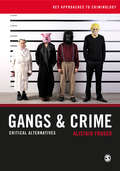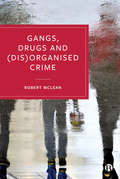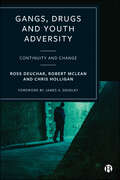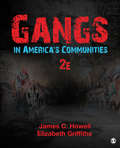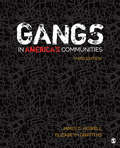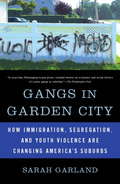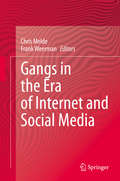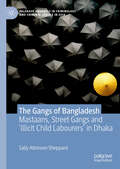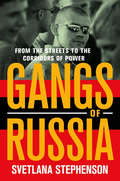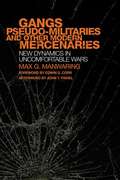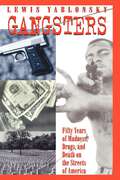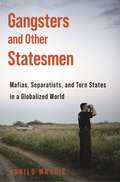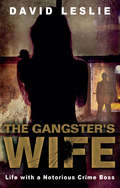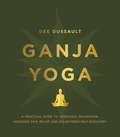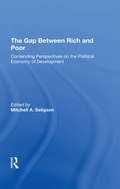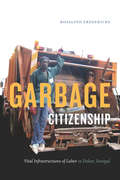- Table View
- List View
Gangs & Crime: Critical Alternatives (Key Approaches to Criminology)
by Alistair FraserThis book takes students on a guided tour of the gang phenomenon through history, as well as current representations of gangs in literature and media. It includes: - A detailed global overview of gang culture, covering, amongst others, Glasgow, Chicago, Hong Kong, and Shanghai - A chapter on researching gangs which covers quantitative and qualitative methods - Extra chapter features such as key terms, chapter overviews, study questions and further reading suggestions. Alistair Fraser brings together gang-literature and critical perspectives in a refreshingly new way, exploring ‘gangs’ as a social group with a long and fascinating history.
Gangs & Crime: Critical Alternatives (Key Approaches to Criminology)
by Alistair FraserThis book takes students on a guided tour of the gang phenomenon through history, as well as current representations of gangs in literature and media. It includes: - A detailed global overview of gang culture, covering, amongst others, Glasgow, Chicago, Hong Kong, and Shanghai - A chapter on researching gangs which covers quantitative and qualitative methods - Extra chapter features such as key terms, chapter overviews, study questions and further reading suggestions. Alistair Fraser brings together gang-literature and critical perspectives in a refreshingly new way, exploring ‘gangs’ as a social group with a long and fascinating history.
Gangs, Drugs and (Dis)Organised Crime
by Robert McLeanDrawing upon unique empirical data based on interviews with high-profile ex-offenders and experts, this book sheds new light on drug markets and gangs in the UK. The study shows how traditional methods of tackling gang violence fail to address the intertwined nature of those criminal activities which can overlap with other organised crime spheres. McLean sparks new debate on the subject, offering solutions and alternatives.
Gangs, Drugs and Youth Adversity: Continuity and Change
by Ross Deuchar Robert McLeanIn Glasgow, street gangs have existed for decades, with knife crime becoming a defining feature. More than a decade on from Deuchar’s original fieldwork, this book explores the transitional experiences of some of the young men he worked with, as well as the experiences of today’s young people and the practitioners who work to support them. Through empirical data, policy analysis and contemporary insights, this dynamic book explores the evolving nature of gangs, and the contemporary challenges affecting young people including drug distribution, football-related bigotry and the mental health repercussions emerging from social media.
Gangs, Guns and Knives: Activities and Lesson Plans to Raise Awareness with Young People Aged 14-19 about the Risks and Realities of Gang-Related Crime
by Vanessa RogersThis is an essential handbook for youth workers, teachers, social workers and youth justice practitioners working with young people to raise awareness about the risks and realities of gangs and gang-related crime.Each activity offers a different learning experience including quizzes, worksheets, games and interactive activities. The book explores peer pressure, loyalty and personal responsibility as well the impact that violent crime can have on individuals, family, community and wider society. It also considers the ethical and moral dilemmas of gang life, serious youth violence and crime and the potential consequences of gang membership and carrying a weapon.Written by a renowned youth worker and trainer, this essential book helps young people to separate myth from fact, build assertiveness and develop the skills to make safe choices.
Gangs in America III
by Dr C. Ronald HuffAs communities face ever-growing gang-related problems, Gangs in America III provides the most up-to-date information on the diverse perspectives and complex issues that arise in our efforts to understand, prevent, and control gang violence and crime.
Gangs in America's Communities
by James C. Howell Elizabeth A. GriffithsGangs in America's Communities offers a comprehensive, up-to-date, and theoretically grounded approach to gangs and associated youth violence. Authors Dr. James C. Howell and Dr. Elizabeth Griffiths introduce readers to the foundations of gang studies through the origins of gangs, definitions and categories of youth/street gangs, transnational as well as prison gangs (and the distinctions between these arguably different types), national trends in gang presence and gang-related violence across American cities, distinguishing attributes of serious street gangs, and myths and realities. Students and instructors will benefit from the Second Edition’s comprehensive treatment of the state of the literature on individual-level causes and consequences of gang membership. Going beyond the traditional topics covered in most texts in the market, this book uniquely describes specific gang patterns, trends, and cultures within a group-based structure while illuminating the most promising avenues for reducing the presence and seriousness of gangs in American communities.
Gangs in America's Communities
by James C. Howell Elizabeth A. GriffithsGangs in America's Communities offers a comprehensive, up-to-date, and theoretically grounded approach to gangs and associated youth violence. Authors Dr. James C. Howell and Dr. Elizabeth Griffiths introduce readers to the foundations of gang studies through the origins of gangs, definitions and categories of youth/street gangs, transnational as well as prison gangs (and the distinctions between these arguably different types), national trends in gang presence and gang-related violence across American cities, distinguishing attributes of serious street gangs, and myths and realities. Students and instructors will benefit from the Second Edition’s comprehensive treatment of the state of the literature on individual-level causes and consequences of gang membership. Going beyond the traditional topics covered in most texts in the market, this book uniquely describes specific gang patterns, trends, and cultures within a group-based structure while illuminating the most promising avenues for reducing the presence and seriousness of gangs in American communities.
Gangs in America's Communities
by James C. Howell Elizabeth A. GriffithsGangs in America's Communities, Third Edition blends theory with current research to help you identify essential features associated with youth violence and gangs, as well as apply strategies for gang control and prevention. Authors Dr. James C. Howell and Dr. Elizabeth Griffiths introduce you to theories of gang formation, illustrate various ways of defining and classifying gangs, and discuss national trends in gang presence and gang-related violence across American cities. They also offer evidence-based strategies for positioning communities to prevent, intervene, and address gang activity. New to the Third Edition: A series of new case studies document the evolution of numerous gangs in large cities, including the community aspect, evolutionary nature, and how cities influence levels of violence. New discussions highlighting the role of social media, insights into how gangs use it to recruit members, and the response from law enforcement. Current nationwide gang trends are discussed to encourage you to analyze and interpret the most recent statistics for which representative data is available. Updated macro and micro gang theories enable you to explore a recent encapsulation of leading developmental models. New discussions around female gang members offer you potentially effective programs for discouraging females from joining gangs—along with highly regarded delinquency prevention and reduction programs that have the potency to be effective in reducing gang crimes among young women. A comprehensive gang prevention, intervention, and suppression program in Multnomah County, Oregon shows how theory was successfully applied to reduce gang activity in a local community. New research on “gang structures” and their rates of crime illustrate the connections between violent crimes and the amount of violent offenders within a gang. Additional discussion of distinguishing features (e.g., typologies) of major gangs, and numerous examples of gang symbols, tattoos, and graffiti has been added to help readers identify and differentiate various types of gangs.
Gangs in America's Communities
by James C. Howell Elizabeth A. GriffithsGangs in America's Communities, Third Edition blends theory with current research to help you identify essential features associated with youth violence and gangs, as well as apply strategies for gang control and prevention. Authors Dr. James C. Howell and Dr. Elizabeth Griffiths introduce you to theories of gang formation, illustrate various ways of defining and classifying gangs, and discuss national trends in gang presence and gang-related violence across American cities. They also offer evidence-based strategies for positioning communities to prevent, intervene, and address gang activity. New to the Third Edition: A series of new case studies document the evolution of numerous gangs in large cities, including the community aspect, evolutionary nature, and how cities influence levels of violence. New discussions highlighting the role of social media, insights into how gangs use it to recruit members, and the response from law enforcement. Current nationwide gang trends are discussed to encourage you to analyze and interpret the most recent statistics for which representative data is available. Updated macro and micro gang theories enable you to explore a recent encapsulation of leading developmental models. New discussions around female gang members offer you potentially effective programs for discouraging females from joining gangs—along with highly regarded delinquency prevention and reduction programs that have the potency to be effective in reducing gang crimes among young women. A comprehensive gang prevention, intervention, and suppression program in Multnomah County, Oregon shows how theory was successfully applied to reduce gang activity in a local community. New research on “gang structures” and their rates of crime illustrate the connections between violent crimes and the amount of violent offenders within a gang. Additional discussion of distinguishing features (e.g., typologies) of major gangs, and numerous examples of gang symbols, tattoos, and graffiti has been added to help readers identify and differentiate various types of gangs.
Gangs in Garden City: How Immigration, Segregation, and Youth Violence are Changing America's Suburbs
by Sarah GarlandFor the past five years, journalist Sarah Garland has followed the lives of current and former gang members living in Hempstead on the border of Garden City, Long Island. Affiliated with Mara Salvatrucha and 18th Street, their troubling personal stories expose the cruel realities of segregation, racial income gaps, and poverty that lie hidden behind suburban white picket fences. As Garland travels from Los Angeles to El Salvador and back to the East Coast, she reveals a disturbing cycle of poverty in which families, fleeing from troubled Central American cities, move into America’s suburban backyards, only to find the pattern of violence repeating itself. Brilliantly reported and sensitively told,Gangs in Garden Citydraws back the veil on a hidden, troubling world.
Gangs in the Era of Internet and Social Media
by Chris Melde Frank WeermanThe ubiquity of the internet and social media has influenced the lives of people across the globe, including young people involved in street gangs and troublesome youth groups. This development raises important questions about the causes, features, and consequences of online gang behavior, as well as the consequences of this new phenomenon for gang prevention and intervention. In this edited volume, members of an international network of gang researchers, the Eurogang Program of Research, present findings and insights from recent academic gang studies focused on the use of internet and social media. It focuses on online features of gangs and the consequences of social media for the study of these groups. The second section of the book focuses on the meaning of online media for the prevention, monitoring and intervention of gangs, and for gang disengagement processes. This is the first volume focused on the role of internet and social media in the study of gangs. Providing much needed insights into online gang processes, it will appeal to students and researchers interested in gangs and juvenile delinquency, and to professionals, practitioners, and policy-makers working on preventing or reducing gang involvement and delinquent behavior.
The Gangs of Bangladesh: Mastaans, Street Gangs and ‘Illicit Child Labourers’ in Dhaka (Palgrave Advances in Criminology and Criminal Justice in Asia)
by Sally Atkinson-SheppardThis book presents a study of street children’s involvement as workers in Bangladeshi organised crime groups based on a three-year ethnographic study in Dhaka. The book argues that ‘mastaans’ are Bangladeshi mafia groups that operate in a market for crime, violence and social protection. It considers the crimes mastaans commit, the ways they divide labour, and how and why street children become involved in these groups. The book explores how street children are hired by ‘mastaans’, to carry weapons, sell drugs, collect extortion money, commit political violence and conduct contract killings. The book argues that these young people are neither victims nor offenders; they are instead ‘illicit child labourers’, doing what they can to survive on the streets. This book adds to the emerging fields of the sociology of crime and deviance in South Asia and ‘Southern criminology’.
Gangs of Russia: From the Streets to the Corridors of Power
by Svetlana StephensonSince their spectacular rise in the 1990s, Russian gangs have remained entrenched in many parts of the country. Some gang members have perished in gang wars or ended up behind prison bars, while others have made spectacular careers off the streets and joined the Russian elite. But the rank and file of gangs remain substantially incorporated into their communities and society as a whole, with bonds and identities that bridge the worlds of illegal enterprise and legal respectability.In Gangs of Russia, Svetlana Stephenson explores the secretive world of the gangs. Using in-depth interviews with gang members, law enforcers, and residents in the city of Kazan, together with analyses of historical and sociological accounts from across Russia, she presents the history of gangs both before and after the arrival of market capitalism.Contrary to predominant notions of gangs as collections of maladjusted delinquents or illegal enterprises, Stephenson argues, Russian gangs should be seen as traditional, close-knit male groups with deep links to their communities. Stephenson shows that gangs have long been intricately involved with the police and other state structures in configurations that are both personal and economic. She also explains how the cultural orientations typical of gangs--emphasis on loyalty to one's own, showing toughness to outsiders, exacting revenge for perceived affronts and challenges--are not only found on the streets but are also present in the top echelons of today's Russian state.
Gangs (Opposing Viewpoints Series)
by Adela SolizA compendium of viewpoints--both pro and con--on several issues relating to the prevalence of gangs in American society.
Gangs, Pseudo-Militaries, and Other Modern Mercenaries: New Dynamics in Uncomfortable Wars (International and Security Affairs Series #6)
by Max G. Manwaring Edwin G. Corr John T. Fishel<p>As the first decade of the twenty-first century has made brutally clear, the very definitions of war and the enemy have changed almost beyond recognition. Threats to security are now as likely to come from armed propagandists, popular militias, or mercenary organizations as they are from conventional armies backed by nation-states. In this timely book, national security expert Max G. Manwaring explores a little-understood actor on the stage of irregular warfare—the gang. <p>Since the end of the Cold War, some one hundred insurgencies or irregular wars have erupted throughout the world. Gangs have figured prominently in more than half of those conflicts, yet these and other nonstate actors have received little focused attention from scholars or analysts. This book fills that void. <p>Employing a case study approach, and believing that shadows from the past often portend the future, Manwaring begins with a careful consideration of the writings of V. I. Lenin. He then scrutinizes the Piqueteros in Argentina, gangs in Colombia, private armies in Mexico, Hugo Chavez's use of popular militias in Venezuela, and the looming threat of Al Qaeda in Western Europe. <p>As conventional warfare is increasingly eclipsed by these irregular and “uncomfortable” wars, Manwaring boldly diagnoses the problem and recommends solutions that policymakers should heed.</p>
Gangster States: Organized Crime, Kleptocracy and Political Collapse
by Katherine HirschfeldThe author draws on behavioral ecology to predict the evolution of organized crime in unregulated systems of exchange and the further development of racketeer economies into unstable kleptocratic states. The result is a new model that explains the expansion and contraction of political-economic complexity in prehistoric and contemporary societies.
Gangsters: 50 Years of Madness, Drugs, and Death on the Streets of America
by Lewis YablonskyWhy young people participate in violent gang behaviorThe effects of gang violence are witnessed every day on the streets, in the news, and on the movie screen. In all these forums, gangs of young adults are associated with drugs and violence. Yet what is it that prompts young people to participate in violent behavior? And what can be done to extract adolescents from the gangster world of crime, death, and incarceration once they have become involved? In Gangsters: 50 Years of Madness, Drugs, and Death on the Streets of America, Lewis Yablonsky provides answers to the most baffling and crucial questions regarding gangs. Using information gathered from over forty years of experience working with gang members and based on hundreds of personal interviews, many conducted in prisons and in gang neighborhoods, Yablonsky explores the pathology of the gangsters' apparent addiction to incarceration and death.Gangsters is divided into four parts, including a brief history of gangs, the characteristics of gangs, successful approaches for treating gangsters in prison and the community, and concluding with a review and analysis of notable behavioral and social scientific theories of gangs. While condemning their violent behavior in no uncertain terms, Yablonsky offers hope through his belief that, given a chance in an effective treatment program, youths trapped in violent behavior can change their lives in positive ways and, in turn, facilitate positive change in their communities and society at large.
Gangsters and Other Statesmen: Mafias, Separatists, and Torn States in a Globalized World
by Danilo MandićHow global organized crime shapes the politics of borders in modern conflictsSeparatism has been on the rise across the world since the end of the Cold War, dividing countries through political strife, ethnic conflict, and civil war, and redrawing the political map. Gangsters and Other Statesmen examines the role transnational mafias play in the success and failure of separatist movements, challenging conventional wisdom about the interrelation of organized crime with peacebuilding, nationalism, and state making.Danilo Mandić conducted fieldwork in the disputed territories of Kosovo and South Ossetia, talking to mobsters, separatists, and policymakers in war zones and along major smuggling routes. In this timely and provocative book, he demonstrates how globalized mafias shape the politics of borders in torn states, shedding critical light on an autonomous nonstate actor that has been largely sidelined by considerations of geopolitics, state-centered agency, and ethnonationalism. Blending extensive archival sleuthing and original ethnographic data with insights from sociology and other disciplines, Mandić argues that organized crime can be a fateful determinant of state capacity, separatist success, and ethnic conflict.Putting mafias at the center of global processes of separatism and territorial consolidation, Gangsters and Other Statesmen raises vital questions and urges reconsideration of a host of separatist cases in West Africa, the Middle East, and East Europe.
The Gangster's Wife: An Empire Built on Cards
by David LeslieFor almost four decades, Margaret 'Mags' McGraw was a keeper of secrets. Her husband, Tam, the notorious 'Licensee', amassed a fortune by leading a safe-cracking gang before masterminding a spectacular £50-million drugs racket.Mags was a devotee of Tarot cards and fortune telling, so when Tam and his associates wondered whether luck would be with them, it was to her that they turned. But Mags discovered that the cards warned of much more than years in prison cells: they predicted death. She learned that her own husband was also doomed to a fate that was unexpected by everyone but her: Tam died in the arms of the wife he called his 'rock' while her secret lover frantically tried to save him.In The Gangster's Wife, Mags reveals her gripping life story, from being a London clippie through often hilarious days running an ice-cream van during the infamous Glasgow Ice Cream Wars to managing a notorious bar, being agony aunt to the toughest criminals around, hiding a secret love and sharing a life with The Licensee.
Ganja Yoga: A Practical Guide to Conscious Relaxation, Soothing Pain Relief, and Enlightened Self-Discovery
by Dee Dussault Georgia BardiFrom the first yoga instructor to bring cannabis-enhanced yoga classes to North America, a groundbreaking guide to finding balance in our lives using the ancient method of mixing cannabis with spiritual practice.Yogis have been using cannabis to enhance spiritual practice for millennia. Today, there is a quiet but growing conversation within the Western yoga community about the potential role of cannabis for modern seekers pursuing a spiritual path. Now, certified yoga instructor Dee Dussault takes this ancient practice mainstream. Ganja Yoga isn’t just mixing cannabis and exercise; it is a ceremony that makes conscious relaxation an intentional ritual that can be enhanced with practice—a lifestyle to help you create a more harmonious and stress-free world. For some contemporary yoga adherents, marijuana can deepen awareness, acceptance, connection, and relaxation during practice. As state laws loosen and the stigma surrounding marijuana dissipates, cannabis is increasingly seen as a legitimate supplement to increased health and wellbeing. Ganja Yoga explains how to set up a sacred space that allows you to use this relaxing substance with yoga for enlightenment (or at least some awesome stretching and meditation). Dee walks you through the considerations and best practices for introducing cannabis into your yoga practice, or infusing yoga into your smoking routine. But it’s not about being stoned out of your head—as Dee says, it’s like adding spice to your food. In Ganja Yoga, she explains how to:Reap the benefits of profound relaxationAssume an altered state in a safe, energizing wayDeepen the spiritual practice of yogaReconnect with the body using ancient techniquesSelect the best setting, time, method of consumption, strains, poses, and breathing techniques to ensure an excellent experienceWhether you want to practice in a class or in the privacy of your own home, Ganja Yoga is your key to reaching a new spiritual high.
Ganztagsbildung: Kooperation von Jugendhilfe und Schule? (Soziale Arbeit als Wohlfahrtsproduktion #26)
by Karin Böllert Jana Demski Oliver BokelmannDer Band stellt aktuelle Diskurse zu Ganztagsbildung mit Blick auf die Kooperation von Jugendhilfe und Schule dar und gibt Impulse zur theoretischen und empirischen Vergewisserung kooperativer Praxis. In den Blick genommen werden das Zusammenwirken verschiedener Bildungsinstitutionen und Akteur*innen, unterschiedliche Bildungsverständnisse sowie differente Erwartungen an Ganztagsbildung. Die Beiträge beschäftigen sich sowohl mit etablierten Formen der Zusammenarbeit über das Handlungsfeld Schulsozialarbeit, Ganztagsbetreuung und Jugendsozialarbeit, als auch mit neuen Perspektiven und Entwicklungen, u. a. im Hinblick auf Fragen von Kinderschutz, Beratung, Bildungslandschaften oder Demokratiebildung. Der Rechtsanspruch auf Ganztagsbetreuung im Grundschulalter ab 2026 unterstreicht die Aktualität der behandelten Thematik.
The Gap Between Rich And Poor: Contending Perspectives On The Political Economy Of Development
by Mitchell A SeligsonIncreasing concern has been expressed by Third World leaders and international organizations alike over the growing gap between rich and poor nations. Between 1950 and 1980 alone, the per capita income gap between low-income and industrialized countries grew from $3,677 to $9,648. In addition, within the developing nations themselves, an ever-widening gap separates the rich from the poor. Other evidence suggests that middle-income countries may be gaining on the rich countries. Some research shows that the gap in education and health is narrowing rather rapidly, and studies of domestic inequality have revealed that growth with equity has occurred in a number of developing nations that have committed themselves to such a policy. This volume presents the evidence for both sides of the debate. It begins by stating the conventional wisdom–that international and internal gaps are widening–and goes on to examine the major explanations offered, which focus on culture, urban bias, dependency, and world-system analysis. The book then presents empirical studies on the existence and causes of the gap, as well as key case studies that challenge the conventional wisdom. Unique in its objectivity, this text does not seek to serve either side of the debate, but instead draws upon the best research in the field to highlight major issues and to present studies that have subjected the differing perspectives to rigorous empirical analysis. It will prove especially useful in courses on Third World development, political economy, comparative politics, development economics, the sociology of development, and related topics.
Gaps and Actions in Health Improvement from Hong Kong and Beyond: All for Health
by Ben Yuk Fai Fong William Chi Wai WongThis book provides a timely review on what has been accomplished, and what remains amiss, following the World Health Organization’s 1978 ‘Health for All’ campaign, by identifying enduring gaps in health care within a global context. The WHO declaration of "Health for All by the Year 2000" mapped out a road towards primary health care for all people and demarcated it as essential for human progress in terms of economic development and social justice. However, 45 years have gone by, and most societies and countries have yet achieved 'health for all’, despite so much having changed in technology, disease patterns, and population demographics. In promoting community health and improving service delivery, the book advocates the development and implementation of “All For Health” strategies to steer stakeholders in the right direction towards universal health care. The book covers the gaps and actions in health improvements, the ‘All For Health’ strategies, and the Health in All Policies (HiAP), reviewing and discussing issues through both Asian and international examples. Contributors include both academics and practitioners from diverse professional backgrounds including medicine, nursing, pharmacy, allied health, dietetics, social sciences, life sciences, education, business, administration, law, and public policy. Essential to scholars in public health and related disciplines, this book is also useful to policymakers, community and public health practitioners, and health care executives and interns.
Garbage Citizenship: Vital Infrastructures of Labor in Dakar, Senegal
by Rosalind FredericksOver the last twenty-five years, garbage infrastructure in Dakar, Senegal, has taken center stage in the struggles over government, the value of labor, and the dignity of the working poor. Through strikes and public dumping, Dakar's streets have been periodically inundated with household garbage as the city's trash collectors and ordinary residents protest urban austerity. Often drawing on discourses of Islamic piety, garbage activists have provided a powerful language to critique a neoliberal mode of governing-through-disposability and assert rights to fair labor. In Garbage Citizenship Rosalind Fredericks traces Dakar's volatile trash politics to recalibrate how we understand urban infrastructure by emphasizing its material, social, and affective elements. She shows how labor is a key component of infrastructural systems and how Dakar's residents use infrastructures as a vital tool for forging collective identities and mobilizing political action. Fleshing out the materiality of trash and degraded labor, Fredericks illuminates the myriad ways waste can be a potent tool of urban control and rebellion.
